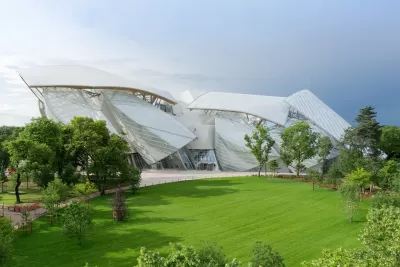Reviewing Douglas Murphy's book "Last Futures: Nature, Technology and the End of Architecture," Jonathan Meades lays into the new utopianism of contemporary architecture. Silicon Valley gets portrayed as both foolish and hypocritical.

Flowery language abounds in Jonathan Meades' review of Douglas Murphy's book Last Futures: Nature, Technology and the End of Architecture. We get a take-down of today's trend toward tech-savvy, Silicon Valley-assisted architecture.
Meades' ideological target is utopianism, specifically the utopian minds that "undertake constant tourism of the unprovable, to enjoy the unsupported conviction that there are big solutions rather than billions of unanswerable questions." In architecture, Meades writes, "it is hardly surprising that the smartest of smart buildings are already being programmed to exercise control over us – caring control, softly spoken – and with a degree of subtlety that quite evaded B.F. Skinner and still evades the uniformed gorillas who patrol gated 'communities' and apartment complexes."
In a critique that could extend to the Silicon Valley ethos as a whole, Meades takes issue with ideologies of liberation via technology—i.e., Buckminster Fuller—that get co-opted by the Googles, Apples, and Amazons, "the most ruthless of modern employers."
Some of architecture's biggest names don't get off lightly. From the review: "Among the other architects on this West Coast gravy train are, predictably, those consummate exterior decorators Frank Gehry and Thomas Heatherwick." Neither does the field of contemporary architecture emerge unscathed: "Gehry and Heatherwick will, as ever, be strenuously plagiarised by their flocks of unimaginative disciples who will, then, be making copies of copies."
FULL STORY: Short Cuts

Planetizen Federal Action Tracker
A weekly monitor of how Trump’s orders and actions are impacting planners and planning in America.

Restaurant Patios Were a Pandemic Win — Why Were They so Hard to Keep?
Social distancing requirements and changes in travel patterns prompted cities to pilot new uses for street and sidewalk space. Then it got complicated.

Map: Where Senate Republicans Want to Sell Your Public Lands
For public land advocates, the Senate Republicans’ proposal to sell millions of acres of public land in the West is “the biggest fight of their careers.”

Orange County, Florida Adopts Largest US “Sprawl Repair” Code
The ‘Orange Code’ seeks to rectify decades of sprawl-inducing, car-oriented development.

Maui's Vacation Rental Debate Turns Ugly
Verbal attacks, misinformation campaigns and fistfights plague a high-stakes debate to convert thousands of vacation rentals into long-term housing.

San Francisco Suspends Traffic Calming Amidst Record Deaths
Citing “a challenging fiscal landscape,” the city will cease the program on the heels of 42 traffic deaths, including 24 pedestrians.
Urban Design for Planners 1: Software Tools
This six-course series explores essential urban design concepts using open source software and equips planners with the tools they need to participate fully in the urban design process.
Planning for Universal Design
Learn the tools for implementing Universal Design in planning regulations.
Heyer Gruel & Associates PA
JM Goldson LLC
Custer County Colorado
City of Camden Redevelopment Agency
City of Astoria
Transportation Research & Education Center (TREC) at Portland State University
Camden Redevelopment Agency
City of Claremont
Municipality of Princeton (NJ)




























